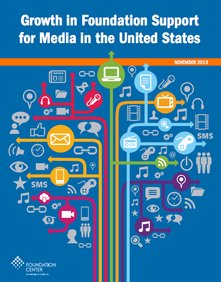
Foundation media support rises—but can it grow even faster?
Photo credit: Flickr user Rob Jewitt.
In 2011, the Federal Communications Commission released the biggest national look at media policy in a generation. “Information Needs of Communities,” based on the Knight Commission of the same name, declared a crisis in local accountability journalism. Part of the remedy, lead author Steve Waldman wrote, was for philanthropists to increase their support for journalism. “An essential first step,” he said, would be to start measuring foundation media grant-making.
That step came today with the release of “Growth in Foundation Support for Media in the United States,” the most comprehensive study yet done on foundation media grant-making. To me, its findings are both a cause for celebration and a call to action.

RELATED LINKS
“Report on foundation funding for media ignites crucial discussion” by Steven Waldman on KnightBlog
The celebration: Foundations are reacting to the digital-age disruption of traditional media. During the study period, 2009-2011, even though a recession was pounding the United States economy, foundations invested more money than ever in media projects. Dollars for media grants grew more than three times faster than overall grant-making and grew to make up a larger percentage of all foundation giving. If media grants were considered a foundation giving category (they aren’t; that’s why a study was needed) media grants would rank seventh, behind the environment and animals but ahead of religion, science and technology.
The call to action: The number of foundations giving media grants (about 2/3 of the total) stayed about the same. That means a third of America’s foundations are not on the path to becoming digital age philanthropists. It can seem a daunting journey. We who have started along the way need to work harder to explain why it’s worth the work. We need to show why foundations need healthy, independent flows of news and information around the topics they care about to achieve their missions. We need to make the case that in the digital age every foundation is now a media foundation, just as every company is a media company.
Still, the good news is that most foundations do see the fundamental role media plays in people’s lives. The numbers in “Growing Foundation Support” reveal the “who, what and where” of U.S. media funding, and show how foundations are reacting to the disruption of traditional media models. The report provides a benchmark from which foundations can improve and learn, while also serving as a resource for grant-seekers.
The study isn’t perfect. It covers only the traditional foundation world of private and community foundations, and not the individuals who are stepping up to launch great new organizations such as ProPublica and The Texas Tribune. That said, giving by traditional foundations can be seen as a symbol of how much social institutions generally care about particular issues. If traditional foundations are doing more in media, it’s a fair bet that more nimble philanthropists are as well.
Celebration: The study’s $1.86 billion investment over three years by 1,012 foundations came despite the recession. Congratulations to the whole report team, including staff from eight foundations, Pew Research Center, the Foundation Center, GuideStar, and the philanthropic network Media Impact Funders.
Call to action: Just 10 foundations invested 42 percent of the total, so there’s room for more large investors as well as growth within the other thousand. Let’s hope Media Impact Funders members can help move those numbers.
So, we’ve taken the first step. We now know that media grant-making is growing. But we have not yet addressed Steve Waldman’s second step. Media grant-making is one thing: Caring about local accountability journalism is something else entirely. It’s a more important something, if you believe that our democratic republic depends upon the checks and balances independent information provides citizens and consumers who need to be able to weed out the scoundrels from good government, honest business and fact-based advocacy.
The study shows the “journalism” subcategory of media grant-making is the largest, totaling roughly 28 percent over three years. More than $527 million sounds like a big investment, but the cost of traditional journalism being lost from the system is more than 10 times that. When it comes to spreading media innovation, foundations that care about “journalistic” uses of technology are outgunned by even bigger ratios. Foundations put in roughly $109 million over three years in the “applications and tools” category, but venture capital investments in Silicon Valley and San Francisco alone invested more than 250 times as much. Venture philanthropists who focus on the democratic functions of media and the social good technology can do should take note. When considering growth, do we have an appropriate sense of urgency?
It comes back to Waldman’s original point to the Federal Communications Commission: “Philanthropists—individuals or foundations—should consider changing their approach to media. Without strong reporting, the issues that philanthropists care about—whether health, environment, children, fiscal responsibility—are all shortchanged. The public will be less well informed and institutions professing to solve the problems will be less accountable.”
Eric Newton is senior adviser to the president at Knight Foundation and author of the new digital book, “Searchlights and Sunglasses: Field Notes From the Digital Age of Journalism.” More about foundations and media can be found in the book “Here for Good” in the chapter he co-authored titled “The Digital Age Foundation.”
Recent Content
-
Journalismarticle ·
-
Journalismarticle ·
-
Journalismarticle ·


